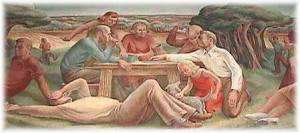The Post Office Murals
category : Arts
 The Horton Post Office was placed on the National Register of Historic Places in 1989. The two murals on the Walls, "Picnic in Kansas" and "Changing of Horses for the Pony Express" were painted by Colorado artist, Kenneth Evett in 1938 and 1939 respectively. The latter is thought to be the only painting of the Pony Express in any Post Office in the United States.
The Horton Post Office was placed on the National Register of Historic Places in 1989. The two murals on the Walls, "Picnic in Kansas" and "Changing of Horses for the Pony Express" were painted by Colorado artist, Kenneth Evett in 1938 and 1939 respectively. The latter is thought to be the only painting of the Pony Express in any Post Office in the United States.The following text is by John W. McManigal, Postmaster, February 1, 1957.
Murals in this Post Office are by Kenneth Evett, at this writing (February, 1957) Associate Professor of Painting, College of Architecture, Cornell University, Ithica, New York.
The painting on the north wall represents a picnic, not necessarily local. Of it the artist says: "This is the first mural I painted. I was still a student at the time, very much influenced by Thomas Benton, and the mural reflects both these facts.
Criticism that the people represented look like Middle-Europeans, Latins, Creoles or what-not, seems to me beside the point. Artists have the right and responsibility to use the images, forms and colors which seem suitable. However, the mural could certainly be criticized as immature and provincial."
 The mural above the Post Office box section "The Pony Express" was hung about one year after "Picnic." It represents a Pony Express rider departing on a fresh mount. Kennekuk, near Horton, was a station on the Pony Express route where riders changed mounts, long before the railroads came to this vicinity. The artist said in 1957: " 'The Pony Express' was more successful in design and color and although I would not work in that style now, I feel that the mural, seen in the context of its time and place, is a respectable piece of work."
The mural above the Post Office box section "The Pony Express" was hung about one year after "Picnic." It represents a Pony Express rider departing on a fresh mount. Kennekuk, near Horton, was a station on the Pony Express route where riders changed mounts, long before the railroads came to this vicinity. The artist said in 1957: " 'The Pony Express' was more successful in design and color and although I would not work in that style now, I feel that the mural, seen in the context of its time and place, is a respectable piece of work."Artist Evett has had three one-man shows at a famous New York gallery, and has exhibited individual paintings in most of the major museums of the United States. He won the national competition to do three murals for the State Capitol building at Lincoln, Nebraska, and these murals, like those in many public buildings, proved controversial.
Come visit us in Kansas, Kansas